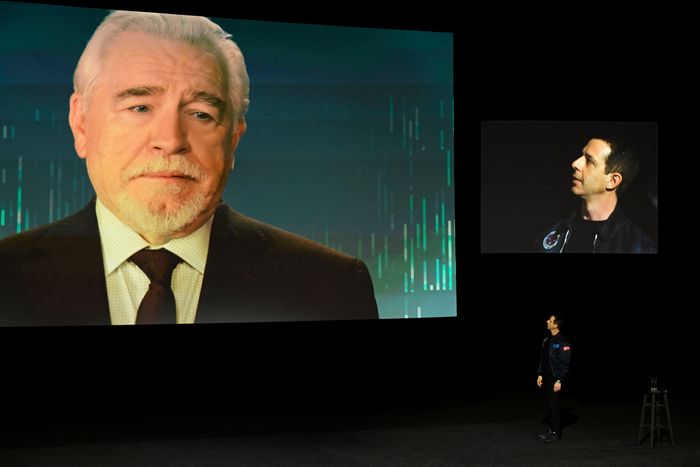
First of all, it must be said that Cousin Greg got the job done. Succession’s sixth episode, “Living+,” hinges on an Investor Day presentation introducing the eponymous new Waystar Royco real-estate concept, which is alternately a landed-cruise-ship experience or a prison camp for the elderly depending on whom you ask. Either way, the entire pitch is held hostage by Kendall’s eagerness to change the value narrative around the structurally declining media conglomerate.
Fueled by tech-bro delirium (with a heaping side of grief), Kendall pushes the finance team to inflate revenue projections, brings a nod toward eternal life into the product story, and enlists Greg to pressure a stage technician into manipulating a video of Logan Roy, first seen at the beginning of the episode, to get the late patriarch to say something that supports Kendall’s crazy forecasts. “What we want him to say is ‘double the earnings’ instead of ‘a significant boost,’” says Greg. The tech demurs, uncertain whether he has the capability to perform the task. “Just fucking make it happen,” Greg replies in a distinctly Greg Hirschian manner of intimidation. And so the technician does.
We’ve seen where Kendall’s flights of stagecraft fancy have taken him before (see “L to the OG,” the “all bangers all the time” birthday party), but miraculously it works out here. The presentation turns out to be a success: Waystar Royco’s stock price soars, possibly making it too expensive for GoJo to buy, and it’s due in no small part to the doctored video providing a patina of legitimacy to Kendall’s moon-shooting.
Is it an act of corporate fraud? Almost certainly. But here’s the bigger question stirring debate in the Vulture Succession Slack: Was that video clip a deep fake or merely the product of skillful editing? (We’re setting aside the obvious explanation that the Succession team probably filmed Brian Cox saying the doctored lines, because what’s the fun in leaving it at that?) To find an answer, we showed the clip to Sam Gregory, the executive director of Witness, an international nonprofit dedicated to supporting the video documentation of human-rights abuses. For the past half-decade, Gregory has also been leading an initiative called “Prepare, Don’t Panic” that works to help the general public better prepare for an AI-generated media future — which is pretty much already here.
“The way this video is filmed is actually quite well set up to make deep fakes,” observes Gregory, who does not watch Succession (but says he will now). “Because it’s static, it’s face-forward against a neutral background, and we’re talking about an individual who presumably has lots of video available of them.”
However, while it’s plausible the clip could be a deep fake, Gregory isn’t certain it is. “It could simply be a conventional edit that’s smoothed over with a jump cut, provided you have the actual words already said somewhere else in the video,” he says, noting that such tools are easily available in editing software such as Adobe Premiere. “Granted, all those tools are informed by AI machine learning in some form or another, but that’s the most mundane explanation.”
To properly assess the clip, one must first grok the reality that there are several different, intersecting ways of committing deep-fakery. Perhaps the most-talked-about method is what’s called a “face-swap,” which broke through into the public not long ago with the famous Tom Cruise deep-fake video. But this also happens to be the most complicated technique to execute, as it requires a significant amount of source material and processing time to produce, along with needing an actual imitator to “perform” the scene, after which AI tools are used to graft the intended face onto the imitator.
That’s obviously not what’s going on in the Investor Day clip, which seems to largely preserve the existing Logan Roy video that was established at the top of the episode. Even if the show did try to attempt a face-swap, the stage team didn’t have that much time to pull it off. After all, it was barely able to construct the Living+ house onstage!
If the clip is indeed a deep fake, it would more likely be the product of what’s called “lip-sync dubbing.” This is when someone uses generative-AI tools to make the lips move along to an audio track, which could either be someone’s real words spliced in from elsewhere — in this case, it would require Logan saying “double the earnings” in another context — or have an imitator say the words and run that recording through any number of widely available voice-cloning technology. According to Gregory, deep-faking audio has gotten significantly easier these days, and, more important, with tools such as ElevenLabs or Microsoft’s VALL-E, you don’t even need that much raw data from the voice of the person you’re trying to spin new words and sentences from.
Whether the doctored clip is a conventional cut or a genuine deep fake, one thing that Gregory points out as being crucial to its effectiveness has to do with how it’s presented. “The success of a manipulated video also depends on the question of plausibility,” he says. “Is there an expectation that people are going to try and poke holes in the claim?” In this case, will Fake Logan claiming that Living+ will “double the earnings” be subject to greater scrutiny? On the one hand, the clip is so fleeting within the presentation that most investors might not second-guess it or feel any possible dips into the uncanny valley. On the other hand, if the claim does get widely circulated, a skeptical investor could pay extra attention to the clip and potentially spot hints of manipulation.
For kicks, I also asked Gregory to assess the video message that Roman receives at the end of the episode, in which Logan’s voice is doctored to say, “I want to make what I think is a fairly historic announcement. I’m convinced that Roman Roy has a microdick and always gets it wrong.” Personally, I had believed this to be a clearer instance of conventional editing. The message sounds more herky-jerky, and I figured it wouldn’t be too difficult to cobble together Logan saying microdick. My colleague Christopher Bonanos, for example, pointed out that mic could’ve been pulled from my confidence, ro from lots of things, and you probably steal a dick from something like dictate. Of course, we never hear Logan say my confidence or dictate in the recording presented to us at the start of the episode, though one could explain it away by saying that we were shown only an excerpt of a longer raw recording session.
But Gregory’s assessment of the video message arose more quickly and with greater certitude than the investor-presentation clip … in the direction that this definitely qualifies as a deep fake. “Audio cloning, most certainly, and then lip-sync matched,” he determined. “That sounds more clearly like someone manipulated his voice to say something he never originally said.”
Roman’s video message struck me as a morally interesting piece of futurism. Using deep-fake tech to manipulate a company’s stock price is pretty straightforward in its legal and ethical violations, but what’s curious about the video message is how it serves, ultimately, as a tool for Roman, famously emotionally stunted, to facilitate his grief.
What does Gregory think about that application of the technology? “Usually, resurrection deep fakes are more political,” he says. “Someone resurrects a murdered journalist to critique the state, which is emotionally powerful.” That said, the use of deep-fake tech for grieving purposes is not unprecedented. Gregory recalls a recent article about a mortuary service in China that uses generative AI to provide grieving people with an avatar of their dead loved ones that can respond to them: “It’s an area that some people are definitely looking at.” Maybe it’s time for Roman to boot up that tired private jet for a trip to China.
More From This Series
- Is Kathleen Kennedy’s Star Wars Empire Ending?
- Maybe Ben Affleck Should Just Read Fan Fiction
- Enjoy J. Smith-Cameron’s Martini-Themed Crossword Puzzle ‘With a Twist’


